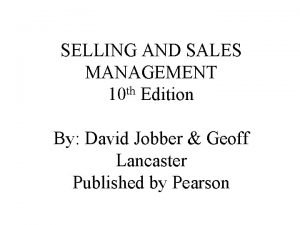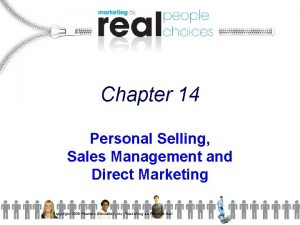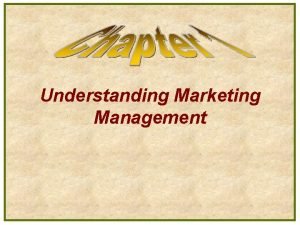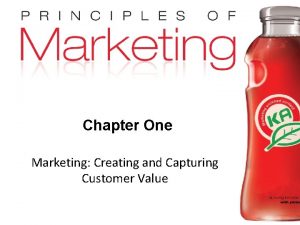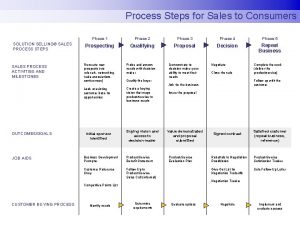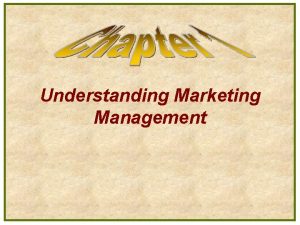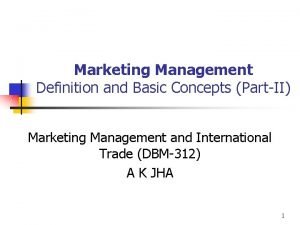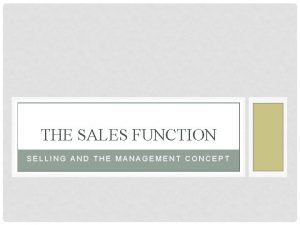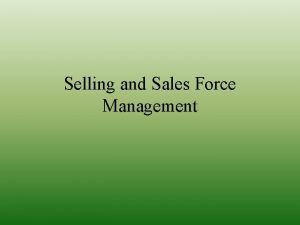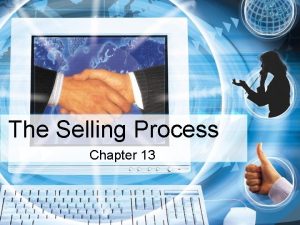THE SALES FUNCTION SELLING AND THE MANAGEMENT CONCEPT













- Slides: 13

THE SALES FUNCTION SELLING AND THE MANAGEMENT CONCEPT

PURPOSE AND GOAL • The purpose of selling is to help customers make satisfying buying decisions, with the goal of creating ongoing, profitable relationships with them. • The marketing concept has created a customer-centered focus that companies have embraced. • Departments coordinate their functions to help the sales function succeed.

CUSTOMER RELATIONSHIP MANAGEMENT (CRM) • Finding customers and keeping them satisfied • • • Websites and Social Media E-Mail Customer Loyalty Programs Computer Software Mobile Device Partnerships

SALES MANAGEMENT • Establishes the guidelines and policies for the sales team • • Company Policies Training Compensation and Sales Quotas Legal and Ethical Issues Sales Pressure Sales Concepts Sales Regulations

SALES CAREERS PERSONAL SELLING

PERSONAL SELLING • Personal selling is any form of direct contact between a salesperson and a customer • Two-way communication between seller and the buyer

TYPES OF SALES POSITIONS • • Retail Industrial and Service Businesses Telemarketing and Non-Profit Internet Web Sites and Sales

STEPS OF A SALE 1. Approach the Customer – greeting the customer face to face 2. Determine Needs – learn what the customer is looking for 3. Present the Product- educating the customer 4. Overcoming Objections – learn why customer is reluctant to buy 5. Close the Sale – getting agreement to buy 6. Suggestion Selling – ad-ons 7. Building Relationships – following up with customers

CUSTOMER DECISION MAKING • Extensive Decision Making – used when there has been little or no previous experience with an item, high degree of risk in the purchase • Buying a car or your first home • Limited Decision Making – used when a person buys goods or services that he or she has purchased before but not regular, moderate degree of risk with the purchase • Prom dress, furniture, household appliances • Routine Decision Making – used when a person needs little information about a product that he or she is buying • Cosmetics, toilet paper, toothpaste

PRELIMINARY ACTIVITIES GETTING READY FOR THE SALE

GETTING READY TO SELL • Product knowledge • Experience • Published materials and Web sites • Industry Trends • Merchandising

CUSTOMER BUYING MOTIVES • Buying Motives – reasons a customer buys a product • Rational Motives – conscious, logical reasons for a purchase • Dependability, time or monetary savings, quality • Emotional Motives – feelings experienced by a customer through association with a product • Social approval, fear, power, love, prestige • Patronage Motives – reasons for remaining a loyal customer of a company • Multiple Motives – most buying decisions involve a combination of motives • EX – people buy car tires for dependability (rational) and fear because they care about safety of loved ones (emotional)

PROSPECTING • Looking for new customers is called prospecting. • A prospect is a potential customer.
 Saint seiya
Saint seiya Selling and sales management
Selling and sales management Pengertian marketing concept
Pengertian marketing concept Newton's classification of selling types
Newton's classification of selling types Personal selling process in sales management
Personal selling process in sales management Types of selling situation
Types of selling situation Marketing info management definition
Marketing info management definition Selling and marketing concept
Selling and marketing concept Solution selling process stages
Solution selling process stages Define marketing management
Define marketing management Selling and marketing concepts contrasted
Selling and marketing concepts contrasted The selling concept is typically practiced with
The selling concept is typically practiced with The selling concept holds that
The selling concept holds that Most firms practice the selling concept when they face
Most firms practice the selling concept when they face

